How to draw lolcats

In his excellent book The Invisible Computer, Donald Norman explains the computer changing from something you might have one of at home (a multi-purpose PC) to an unseen component in special-purpose devices from washing machines and refrigerators to portable telephones and music players. The same thing is happening with graphics software, and this article considers one specific example. Along the way, I also explain how to produce cat macros.
There used to only be one kind of graphics software, which I will call 'Photoshop'. In principle, this is general-purpose software for anything that you might want to do with graphics (by which I mean 2D bitmap images, for the purposes of this article). However, this software has inevitably become more complex and costly over the years, to the point where Photoshop CS3, for example, is only really suitable for design professionals who can justify the time and expense, or similarly dedicated amateurs.
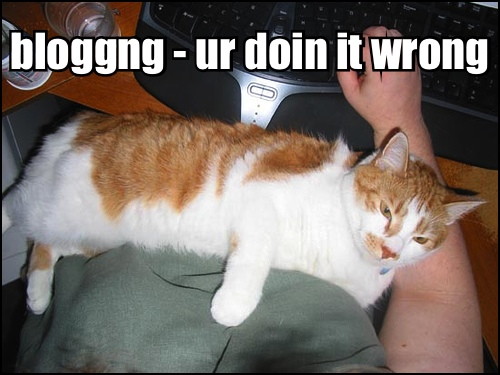
Cat macros (or lolcats), as popularised by I Can Has Cheezburger?, are fairly simple to produce, but there are still rules that make it harder:
-
the photo’s subject must be a cat, preferably a cute kitten
-
the caption is white text in the Impact font
-
the caption has a 3-pixel anti-aliased black outline.
There are also rules about spelling, and which clichés and snowclones make the lolcat funnier, but they are outside the scope of this article.
Photoshop
Photoshop has a layer style that does exactly what we want to a text layer. This is the brute force approach: add every possible feature until it is possible to do anything. The clever thing about Photoshop, of course, is that it remains usable rather than drowning under the weight of feature bloat.
The procedure in Photoshop is as follows.
-
Open the cat photo.
-
Select the text tool, click to place the insertion point and type a caption.
-
Set the text font to Impact and size to 36 pt or 48 pt, say.
-
Select the text layer, then Layer > Layer style… > Stroke and choose these settings:

-
Position the caption.
-
Select File > Save for web and devices… and save the cat macro as a JPEG.
This gives the expected result.

Drawing lolcats in Photoshop is pretty easy, but starting up Photoshop takes half the time, and it is too expensive to use for drawing lolcats.
Exercise for the reader: create a Photoshop macro that adds a default caption in the correct style - a kind of cat macro macro.
Comic Life
Comic Life is a specialist graphics application, designed for producing comics. Comic Life has one killer feature that is useful for drawing lolcats: funky lettering styles.
First, create a lolcat lettering style:
-
Create a new document.
-
Drag 'LETTERING' onto the page, and in the dialogue box click the Place Lettering button.
-
With the lettering selected, select the Details pane on the right-hand inspector, and choose the following settings, and then select Save as in the Style Attributes section in the middle of the inspector and save a new lolcat style.
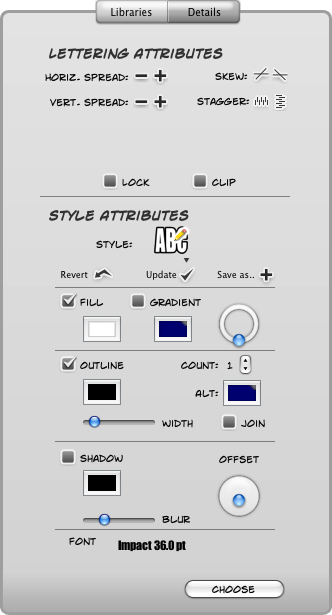
Now draw the lolcat:
-
create a new comic
-
select Page Format and set the size in points to the photo dimensions in pixels
-
drag the ONE panel from the Built-in: Basic library on to the page, to fill the page
-
drag the photo into the panel, which it resizes to fill
-
drag 'Lettering' onto the frame, and in the dialogue box enter your caption
-
select the 'lolcat' style you created earlier, and resize the text frame to put the letter proportions back to normal
-
select Export to Image(s) and save a JPEG.
The most useful feature in Comic Life here, apart from the lettering style, is that you can put a frame on the page if you want a border around each image, such that you can just drag and drop photos into the frame (shown here with a light blue background and black border), and the photo is automatically cropped scaled to fill the frame. For this to work well, the frame has to have the correct proportions, which is why you need to set the page size first.
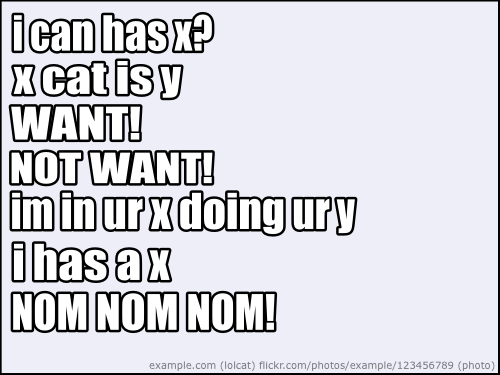
However, the text frame does not seem to fill the page well enough for a pixel-perfect export.
An even bigger annoyance is that the text frame size stays the same when you edit the text or change the style, which means that you have to manually stretch the text horizontally. For example, if you remove half of a caption, the remaining letters become twice as wide. This also happens when you place new text, because the default style uses a wider font than Impact, so selecting the previously saved 'lolcat' lettering style results in expanded Impact characters. (This has been mentioned on the Comic Life forum.)
Drawit Lite
Drawit Lite is a vector drawing application that has the key advantages of being extremely simple to use, and handling bitmap images well. Drawing lolcats in Drawit Lite is extremely simple:
-
open the photo in Drawit Lite, which sets the canvas size
-
insert a text layer, and enter the caption
-
set the text attributes and add a Stroke effect as follows:
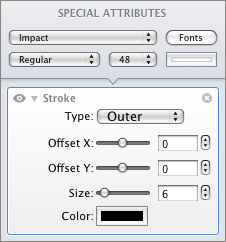
-
export as a JPEG.
The only thing that would make this faster would be the ability to save the text style, so Drawit Lite is the best option so far.
Note that one cool feature about using Drawit for this kind of thing is that if you zoom in, it behaves like a bitmap tool and shows you bigger pixels, which makes it a kind of export preview.
Microsoft Office
This post on icanhascheezburger.com suggests the possibility of built-in Office functionality:
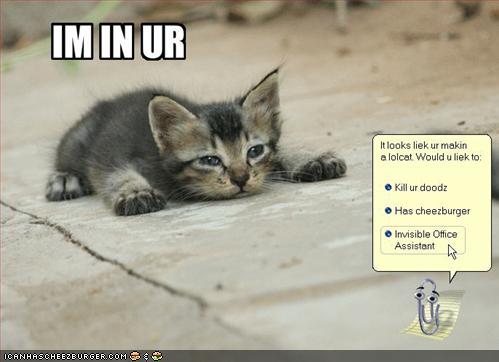
However, plausible though the parody is, even Microsoft Word does not have so much feature bloat that it includes lolcat support. Perhaps it would be different if Microsoft ever managed to develop a decent graphics application. (Does anyone actually use Expression?)
PHP-based web application
The simplest cat macro tool turns out to be a web application, which makes sense when you consider how little user-interaction is really required. For example, with the Big Huge Labs Lolcat Generator, you simply choose a photo, text for the top or bottom, and left, centre or right alignment. The results are good and, crucially, follow the rules.
The roflbot is a more sophisticated version of the same thing, that lets you position the text by dragging with the mouse. Sadly, the built in pictures are not all cats.
This is the best kind of web application; done well, the software is almost invisible, like the computer in Donald Norman’s washing machine.
Special-purpose graphics applications
Photoshop may still be the ultimate general-purpose bitmap image editing tool, but despite the likes of Photoshop Elements and the GIMP, there are enough niche applications and plenty of room for special-purpose graphics applications, even as web applications.
